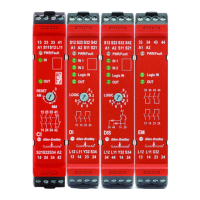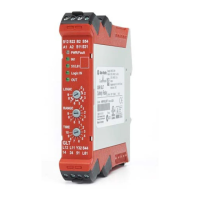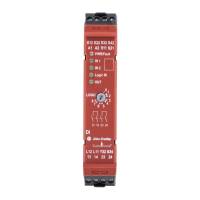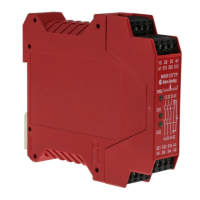Rockwell Automation Publication 440R-UM013G-EN-P - December 2022 37
Chapter 6
Pulse Testing Functions
Safety relays use pulse testing of inputs and outputs to verify that the safety function is
performed when called upon. Pulse testing for the inputs must be used with devices with
mechanical contacts like E-stop push buttons, tongue operated interlock switches, and limit
switches. The pulse testing cannot be turned on or off and cannot be changed.
The test pulses are used to detect three short circuit conditions:
• Between the input terminals and +24V.
• Between the input terminals and 24V common.
• Between the two input terminals.
Pulse Testing for Inputs Pulse testing for the inputs is generated on terminals S11 and S21 of the CI, DI, DIS, and SI safety
relays. The EM and EMD safety relays do not use pulse testing.
CI Safety Relay
The pulse testing that is associated with the CI safety relay is shown in Figure 29. The pulse
widths are 2.5 ms wide. The pulse testing on S11 and S21 is offset by 1 ms. The pulses are
repeated every 14 ms.
Figure 29 - Pulse Test Sequence for CI Safety Relay
DI, DIS, and SI Safety Relays
The pulse test sequence for the DI, DIS, and SI safety relays are shown in Figure 30 on page 38.
The sequence is repeated every 12.2 ms.
IMPORTANT The pulse test sequences are provided for informational purposes. All
timing values are approximate.
When using a digital multimeter, S11 measures approximately 19V and S21
measures approximately 19V when the supply voltage to A1 is 24V DC and the input
circuits are open.
At the minimum-rated input on voltage (11V), a DC multimeter reads approximately
8.9V DC at S12 and S22.
0
24V
0V
S11
S21
24V
0V
2.5 3.5 6 14

